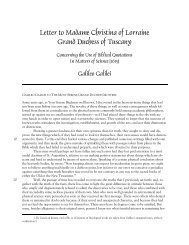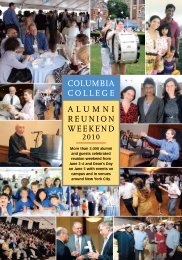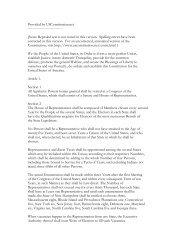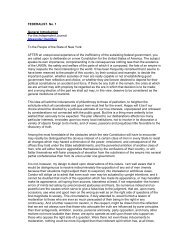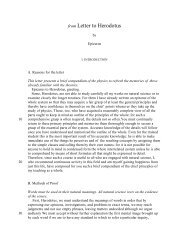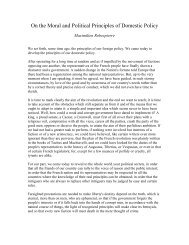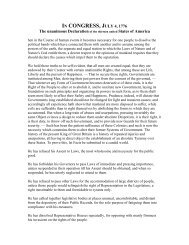Download this issue as a PDF - Columbia College - Columbia ...
Download this issue as a PDF - Columbia College - Columbia ...
Download this issue as a PDF - Columbia College - Columbia ...
You also want an ePaper? Increase the reach of your titles
YUMPU automatically turns print PDFs into web optimized ePapers that Google loves.
HURRICANE SANDY<br />
COLUMBIA COLLEGE TODAY<br />
COLUMBIA COLLEGE TODAY<br />
HURRICANE SANDY<br />
stop for weeks — shoveling sand off the boardwalk, organizing<br />
volunteers, knocking on businesses’ doors to see what they<br />
needed — and soon thereafter helped launch an initiative called<br />
#ConeyRecovers. Operating under the auspices of the Alliance<br />
for Coney Island, #ConeyRecovers is a central resource for grants<br />
and information to help residents and business owners rebuild.<br />
City Hall took note of Bliss’ actions, and in early December he<br />
w<strong>as</strong> named leader of a newly created Business Recovery Zone in<br />
south Brooklyn, t<strong>as</strong>ked with helping small businesses get back<br />
on their feet. Shortly after that, EDC President Seth Pinsky ’93<br />
<strong>as</strong>ked Bliss to join the citywide Special Initiative for Rebuilding<br />
and Resiliency. The initiative, headed by Pinsky at the behest of<br />
Mayor Michael Bloomberg, will make recommendations on how<br />
New York City should rebuild from Sandy and prepare for the<br />
impact of climate change on critical systems and infr<strong>as</strong>tructure.<br />
The group’s report w<strong>as</strong> due in May.<br />
Dis<strong>as</strong>ters make for extraordinary times, and though some of<br />
his responsibilities will dial down <strong>as</strong> the recovery moves forward,<br />
Bliss h<strong>as</strong> put in a lot of evening and weekend hours to keep up<br />
with it all. But his EDC colleagues, he says, work just <strong>as</strong> hard; long<br />
hours go with the territory. Fortunately, he enjoys what he does.<br />
“It’s a privilege to help New York City and its neighborhoods and<br />
residents reach their full potential,” he says. “It’s rewarding work.”<br />
The morning after the storm, Bliss w<strong>as</strong> one of the first city<br />
employees to reach Coney Island. Driving down Ocean<br />
Parkway from his home in Prospect Heights, he knew<br />
things were bad before he even reached the northern<br />
edge of the neighborhood. Electricity w<strong>as</strong> out, cars were scattered<br />
pell-mell and sand covered the road several blocks inland. “The<br />
scariest thing w<strong>as</strong> when people started opening their doors and<br />
rolldown gates and seeing what w<strong>as</strong> behind them,” says Bliss. “It<br />
w<strong>as</strong> five to eight feet of stillwater flooding that killed us in Coney<br />
Island.”<br />
Some landmarks were shuttered for months, including the<br />
New York Aquarium, which had been a week away from breaking<br />
ground on a 57,000-square-foot shark exhibit and suffered $65<br />
million in damage, and the original Nathan’s Famous hot dog<br />
emporium, which had never closed a day in its 96-year history.<br />
Both reopened in May.<br />
That first day, Bliss set up an impromptu relief center in the<br />
parking lot of MCU Park, the Brooklyn Cyclones’ b<strong>as</strong>eball stadium.<br />
The parking lot quickly became an operations b<strong>as</strong>e from<br />
which Bliss directed the efforts of volunteers and a host of aid<br />
groups including the American Red Cross, FEMA and the National<br />
Guard. Barely a year earlier, Bliss had taken a cat<strong>as</strong>trophe<br />
response cl<strong>as</strong>s while studying for a m<strong>as</strong>ter’s in real estate from<br />
NYU. Now, he faced a full-on cat<strong>as</strong>trophe in his own backyard.<br />
Lola Star, who owns the Lola Star Souvenir Boutique on the<br />
boardwalk, says that Bliss “w<strong>as</strong> an absolute hero” in those first<br />
awful days. “I don’t know what we would have done without<br />
Nate,” says Star. “His dedication to and love for Coney Island<br />
during <strong>this</strong> tragedy were absolutely extraordinary.”<br />
The image of Bliss shoveling sand off the boardwalk is one that<br />
will stay with the Wonder Wheel’s Vourderis, but he already knew<br />
of Bliss’ dedication from years of working with him on redevelopment<br />
efforts. “He’s at meetings, he’s at grand openings, he’s at ribbon<br />
cuttings,” says Vourderis, whose family h<strong>as</strong> owned the Wonder<br />
Wheel and adjacent amusement park for 40 years. “He’s part<br />
of the family, part of the fabric that makes up Coney Island today.”<br />
Vourderis sees in Bliss a sincerity and attention to detail not<br />
often found in city staffers. “A lot of these guys will give you lip<br />
service, but not Nate,” he says. “Nate gets stuff done. He’s not<br />
afraid to get his feet wet, to get his hands dirty.”<br />
Pinsky, Bliss’ boss at the EDC, says that Bliss combines the<br />
technical and management acumen to see a capital-improvement<br />
project to completion — be it an amusement park or sewer system<br />
— with more intangible qualities.<br />
“Where I think he’s particularly effective is in dealing with the<br />
people in the community, making himself really a trusted partner,”<br />
says Pinsky. “There are a lot of people who bring only one<br />
set of skills. Nate is a unique individual in that he is not just empathetic<br />
but able to turn that empathy into action.”<br />
And even with hurricane recovery dominating their efforts in<br />
recent months, Pinksy adds, “Nate and his team have not lost<br />
sight of the long term and the need to keep thinking strategically<br />
while helping people on a tactical level.”<br />
For his part, Bliss w<strong>as</strong> deeply moved by the community’s determination<br />
to dig out from the hurricane’s wreckage. “People<br />
didn’t sit on their hands for a moment,” he says. “They started<br />
rebuilding their businesses <strong>as</strong> soon <strong>as</strong> they could.”<br />
No one denies, however, that the neighborhood h<strong>as</strong> a long<br />
road ahead. For all the celebratory vibe of opening day, some of<br />
the neighborhood’s 50,000 residents remain displaced and out<br />
of work. Many businesses are yet to reopen; some have closed<br />
for good. “There’s optimism,” Bliss says, “coupled with the new<br />
reality.”<br />
Growing up in Virginia with Yonkers-born grandparents,<br />
Bliss visited New York City frequently enough to<br />
know that he wanted to live there one day. It w<strong>as</strong> one<br />
of the strongest draws for attending <strong>Columbia</strong>, and he<br />
soaked up all the city had to offer — music, food, neighborhoods.<br />
On campus, he w<strong>as</strong> “a real explorer” of academic paths and extracurricular<br />
activities; he tried pre-med before settling on urban<br />
studies <strong>as</strong> his major. For one se<strong>as</strong>on he rowed with the lightweight<br />
crew and became f<strong>as</strong>cinated by what he calls the city’s “forgotten<br />
urban waterfront,” the Harlem River, where the team practices.<br />
He also started a Bliss family tradition: His sisters Rebby ’07,<br />
’13 Business and Samara ’13 both followed him to <strong>Columbia</strong>.<br />
When he’s not working, Bliss is the b<strong>as</strong>sist and backup vocalist<br />
for a pop/punk/indie band called the Aye-Ayes. He’s also planning<br />
his wedding next year to Amira Ibrahim ’05 Barnard. They<br />
didn’t know each other during their time on campus but friends<br />
introduced them shortly after graduation. “So clearly,” says Bliss,<br />
“<strong>Columbia</strong> h<strong>as</strong> had an influence on my life trajectory.”<br />
Bliss’ employment at EDC began in 2005, when he took a summer<br />
internship in its development department. He parlayed the<br />
internship into a full-time job <strong>as</strong> a junior project manager, and in<br />
2010 he w<strong>as</strong> promoted to his current position. All along, Coney<br />
Island h<strong>as</strong> been his territory.<br />
The neighborhood offers a fe<strong>as</strong>t for an urban policy guy to sink<br />
his teeth into: amusement parks, entertainment, a major transit<br />
center, a beach and a diverse population. “The people are awesome,”<br />
says Bliss, who h<strong>as</strong> collaborated with “p<strong>as</strong>tors from local<br />
churches <strong>as</strong> well <strong>as</strong> burlesque dancers and freaks from the entertainment<br />
venues.” And after working side by side with residents<br />
after the hurricane, Bliss says his connection to Coney Island now<br />
“is doubly strong.”<br />
Perched on the southern edge of Brooklyn, about an hour by<br />
subway from Midtown, Coney Island — which actually is not<br />
an island but sits on a peninsula — h<strong>as</strong> drawn recreation seekers<br />
since the 1830s, when sweaty Manhattanites traveled there<br />
by steamship or carriage for a se<strong>as</strong>ide vacation. The first half of<br />
the 20th century w<strong>as</strong> the area’s heyday, especially after subway<br />
service linked Brooklyn to Manhattan in 1915, delivering hordes<br />
of daytrippers to its beach, amusement parks and cheap entertainment.<br />
Following WWII, a number of factors contributed to<br />
Coney Island’s decline: air-conditioning, which made it more<br />
bearable to stay indoors; the expansion of automobile ownership,<br />
which put less-crowded Long Island, New Jersey and Connecticut<br />
beaches within e<strong>as</strong>ier reach; and the city’s overall economic<br />
troubles in the 1970s.<br />
When Bliss started working in Coney Island in 2005, the city<br />
w<strong>as</strong> in the throes of writing a comprehensive plan to stimulate<br />
economic growth in the neighborhood. Securing its distinctive<br />
character <strong>as</strong> an amusement destination w<strong>as</strong> a central piece of<br />
that strategy. At that time, the tr<strong>as</strong>h-strewn, vacant lots along<br />
the boardwalk were being eyed for high-rise hotels and condos,<br />
something few Coney Islanders wanted to see. So the city bought<br />
about seven acres from condo developers — an acknowledgment,<br />
says Bliss, “that amusement parks will have a hard time<br />
surviving, given the vagaries of the real estate market. If the city<br />
w<strong>as</strong> serious about preserving Coney Island, it had to do that.”<br />
The city, however, had no wish to actually operate amusement<br />
parks. A private company runs the two new parks that have gone<br />
up on city-owned land: Luna Park, which opened in 2010, and the<br />
Scream Zone, which opened a year later. Another major project,<br />
Steeplech<strong>as</strong>e Plaza, w<strong>as</strong> set to open on Memorial Day. It will be an<br />
outdoor plaza with retail and performance space and a restored<br />
1919 carousel. Both Luna Park and Steeplech<strong>as</strong>e Park resurrect the<br />
names of long-closed attractions from Coney Island, hearkening<br />
back to its glory days and, the hope is, heralding new ones. Beyond<br />
the amusement zone, a YMCA is under construction and rehabilitation<br />
of several neighborhood parks also is in the works.<br />
In November, New York City voters will elect Bloomberg’s successor.<br />
At the moment, Bliss isn’t heading for the door, but the arrival<br />
of a new administration, he says, is a natural turning point for<br />
someone in his position. Whatever his next job may be, Bliss knows<br />
he’s been fortunate to have begun his career on turf <strong>as</strong> unique and<br />
rich with history <strong>as</strong> Coney Island.<br />
“There’s a saying in Coney Island: ‘Once you have sand in<br />
your shoes, you never get it out,’” says Bliss. “For better or worse,<br />
I’ll always have sand in my shoes.”<br />
Mary Jean Babic is a freelance writer who lives in Brooklyn.<br />
Bliss h<strong>as</strong> been working in Coney Island since 2005 and says wherever his career takes him, “I’ll always have sand in my shoes.”<br />
PHOTO: NATALIE KEYSSAR<br />
SUMMER 2013<br />
52<br />
SUMMER 2013<br />
53




